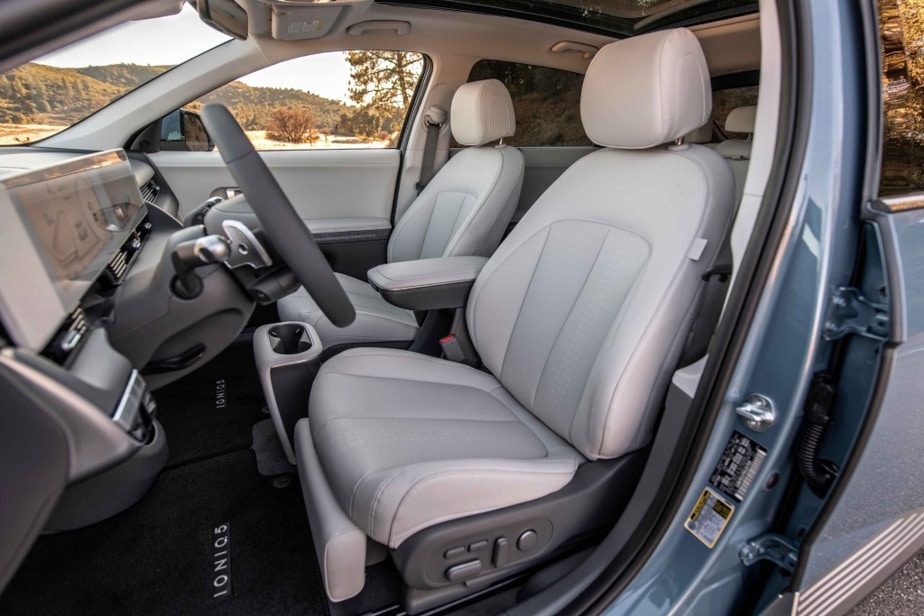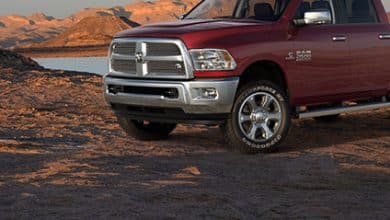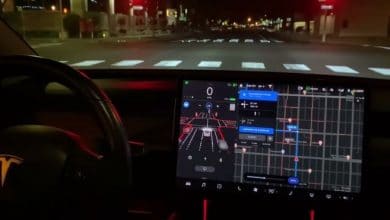Test bench | Ioniq 5: Leading the Charge

Contents
(San Diego, CA) Quiet, clean and visible
With the release of the Ioniq 5, Hyundai is thinking big. In Canada, the South Korean group now holds nearly 16% of the market share in the electric vehicle sector (behind Tesla) and naturally does not intend to stop there.
Beyond certain atypical characteristics, the Ioniq 5 intends to stand out by its availability. Hyundai already promises to quickly honor all the pre-orders registered to date (around 4000).

PHOTO DREW PHILLIPS, SUPPLIED BY HYUNDAI
Ioniq 5
Performed on an exclusive platform (code name E-GMP), the Ioniq 5 takes full advantage of the structural changes that the presence of an electric power unit offers. Especially when it adopts the contours of an SUV. A perfectly flat floor, a creative layout, the architecture of the Ioniq 5 allows its designers a lot of latitude. The small size of the engine, housed on the rear axle (propulsion), and the installation of the batteries under the chassis contribute to freeing up an interior volume comparable to that of a more bulky vehicle.
The Hyundai Ioniq 5 at a glance
Price range: $ 44,999 to $ 59,999 (eligible for government rebates of $ 8,000 and $ 5,000)
Visible in dealerships: from January
WE love
Spacious and comfortable interior
Calming driving of a large highway
Energy and recharging efficiency
We like less
Ergonomics of certain controls to review
Poor dynamic behavior
Dimensions and inertia
Our verdict
The electric revolution is underway
On the outside, the short overhangs highlight the huge wheels positioned at each corner of the body. Like some bourgeois brands, the Ioniq 5 adopts flush door handles. These will undoubtedly require more special attention, in winter, just like the bezel, without a wiper and equipped, on our test model at least, with a very inefficient defroster.
In addition, others will not fail to highlight the squared shapes supposed to evoke the Pony (do you remember that?) Of the time when the Italian designer Giorgetto Giugiaro dressed it. The Ioniq 5 appears massive. Still, it’s barely longer than a Volkswagen ID.4 and bulkier than a Ford Mach-E.

PHOTO DREW PHILLIPS, SUPPLIED BY HYUNDAI
The dashboard features two juxtaposed cobblestones, like some Mercedes.
The interior atmosphere appears more Zen. The beltline gives off a large glass surface, which is reinforced by the panoramic roof available as an option on the most elite version with all-wheel drive. As it is, the range nomenclature includes a choice of two battery sizes for buyers of the rear-wheel drive version.
Consumers who are more interested in all-wheel drive – it has two engines – will be entitled to the most powerful battery.
A little choppy, the dashboard features two juxtaposed cobblestones like some Mercedes. The general presentation seeks to be original, but only partially succeeds. First there is this reclining chair – which lacks shoulder support – which seems to come straight out of the catalog of the La-Z-Boy brand.
The trouble: it’s the driver’s seat. Why not have privileged such softness for the front passenger? And what about the confusing and awkward positioning of the selector which is rooted in the steering column under the branch that controls the wipers.
On the other hand, let us emphasize the reiteration of certain tricks seen on the vans, such as the possibility of sliding the central armrest and the seats of the rear seat. Not to mention the augmented reality head-up display device, a first for the Hyundai group.

PHOTO DREW PHILLIPS, SUPPLIED BY HYUNDAI
Front seats. That of the driver seems to come straight out of the catalog of the brand La-Z-Boy …
Lots of space inside, but the modularity is all in all classic with backrests that fold into two sections and not three (to facilitate the passage of your skis, for example). The tailgate lifts to a competitive cargo volume (770 L), where three golf bags can be transversely accommodated. At the front, we cannot speak of a chest, but of a box.
Efficient, comfortable, but still
Testing an electric vehicle as part of a media launch is always a delicate exercise insofar as the recharging time component is (too often) overlooked. In the case of the Ioniq 5, this is all the more distressing since, in addition to its autonomy, the charging speed is one of the main attributes of its architecture operating at a voltage of 800 V.

PHOTO DREW PHILLIPS, SUPPLIED BY HYUNDAI
Back seat
Furthermore, due to dire weather and road conditions at the time of this handling, it is difficult to confidently establish the consumption of this vehicle. Our best performance was 23.5 kWh / 100 km. This is something to perplex us and which deserves to be cross-checked in the context of a later test.

PHOTO DREW PHILLIPS, SUPPLIED BY HYUNDAI
The Ioniq 5 takes advantage of the structural changes that the presence of an electric power unit offers.
That said, it is nonetheless possible to draw some conclusions about the dynamics of this vehicle. Flowers first. Rather wide and firmly planted on its huge wheels (20 inches), the Ioniq 5 is reassuringly stable and imperturbable in traction (with all-wheel drive, the only drive mode offered on the test).
Note also the silence of the ride and the comfort of the suspension elements on a properly paved road. Assuming its autonomy, the Ioniq 5 represents a pleasant travel companion as long as one adopts a peaceful conduct. Besides, acceleration is not the type to nail you in your seat. To this mix, it is advisable to add an easy to modulate braking and which allows to vary the intensity of the energy recovery.
However, as soon as you increase the pace, the flowers wither.

PHOTO DREW PHILLIPS, SUPPLIED BY HYUNDAI
There is a lot of space inside; the files fall into two sections, not three.
The steering then lacks not only precision, but also responsiveness. Add to that a propensity to understeer (tendency to pull straight through turns) if you push it a bit. Not to mention the weight that paralyzes her in the rapid changes of trajectory. You can feel it at the controls, unless you leave it to the semi-autonomous driving device to do the work for us, as long as the hands maintain direct contact with the rectangular steering wheel.
Deviating from this will be worth, after seven seconds, a call to order on the on-board screen, quickly followed by an audible signal and then by disconnecting the system. Rather efficient, but less sophisticated – some would say more cautious – than that of the Tesla.
Transportation and accommodation costs related to this report were partially paid by Hyundai Canada.
Tell us about your experience
Press will soon publish the test of the following vehicles: Acura RDX, Alfa Romeo Stelvio, Honda Civic Si, Jeep Grand Cherokee, Subaru Forester. If you own one of these vehicles, we would love to hear from you. In addition, if you have recently acquired a used vehicle, we invite you to correspond with us.
Technical sheet
Electric motors
Synchronous with permanent magnets Standard autonomy – propulsion – 1 motor Power: 168 horsepower, torque: 258 lb-ft
Long range – propulsion – 1 engine Power: 225 horsepower, torque: 258 lb-ft
Long range – full – 2 motors Power: 320 hp, torque: 446 lb-ft
Performances
Weight: 1905 kg (Rear wheel drive, standard)
2115 kg (Integral, long autonomy)
Acceleration (0-100 km / h): 5.4 seconds (with all-wheel drive)
Maximum towing capacity: 907 kg
Gearbox
Standard: Automatic Optional: None
Drive mode: Propulsion (rear wheel drive) or full (4 wheel drive)
Recharge time
58 kWh or 77.4 kWh lithium-ion battery
Level 2: 6.43 hours
Level 3: 25 min (10% to 80% of the load)
Full load autonomy *
Standard (rear-wheel drive): 354 km
Large (rear-wheel drive): 488 km
Large (all-wheel drive): 414 km
* Manufacturer’s data
Dimensions
Wheelbase: 3000 mm
Length: 4635.5 mm
Height: 1600 mm
Width: 1890 mm *
* Exterior mirrors folded down
Tires
235 / 55R19
255 / 45R20
A range in the making

PHOTO JOE WILSSENS, SUPPLIED BY HYUNDAI
The Seven Concept, showcased at the Los Angeles Auto Show last month
At the 5, Ioniq, the electric subsidiary of Hyundai, intends to add two other models to its portfolio by 2024. The Ioniq 6, expected in the next year, will take over the features of the Prophecy study, a sedan fitted with opposing doors. Nothing suggests that these will be retained, but everything indicates however that a variation N (sports antenna of Hyundai) will be proposed. As for the Ioniq 7, it will undoubtedly integrate several aesthetic elements of the Seven Concept (our photo) presented at the Los Angeles Auto Show last month.
Good at everything

PHOTO DAVID DEWHURST PROVIDED BY HYUNDAI
The Ioniq 5’s bidirectional power supply allows all kinds of electrical devices to be plugged in.
Among the many advancements of the Ioniq 5 is a two-way power supply that allows all kinds of electrical devices to be plugged in, from the personal computer to the coffee machine. The House ? Not yet, but Hyundai is considering it.
Competition
Ford Mustang Mach-E

PHOTO PROVIDED BY FORD
Mustang Mach-E
Price: from $ 50,495
More massive, more expensive, the Ford Mach-E is more fun to drive than the Ioniq 5. The American also offers less confusing ergonomics. In return, the Mach-E is not eligible for the federal government subsidy (only that of Quebec applies) because of its higher price, and its basic warranty is less generous. However, unlike the Ioniq 5, the Mustang Mach-E refuses to tow any load. The interior also appears less spacious, but the volume of the trunk is more impressive.
Kia EV6

PHOTO PROVIDED BY KIA
Kia EV6
Price: from $ 44,999 (estimate)
Designed under the supervision of Montreal designer Karim Habib, Kia’s EV6 also envelops the E-GMP platform developed by the Hyundai group. This imposing vehicle with sculptural lines and an original light signature is the first of 11 electrified vehicles promised by Kia by 2025. How will the EV6 differ from the Ioniq 5? This remains to be determined, steering wheel in hand (a test bench will be published shortly), but Kia promises a better feeling on the road, a slightly higher towing capacity and a more consensual interior.
Volkswagen ID. 4

PHOTO PROVIDED BY VOLKSWAGEN
Volkswagen ID. 4
Price: from $ 44,995
“The ID.4 will define the future of the German manufacturer in the XXIe century ”, we wrote a few months ago. True, Volkswagen is placing a lot of hope on this electric utility. And just like Hyundai with the Ioniq 5, Volkswagen aspires to become the new leader in the electric transition. It promises.
Like the Ioniq 5, the ID.4 2021 offers two drive modes: propulsion and integral. Its battery is more powerful than that of its South Korean competitor, but on paper, it does not manage to offer better autonomy. On the other hand, the German offers a higher towing capacity (1225 kg), a larger trunk and a more dynamic driving. In return, the presentation is more spartan. Some would say it is more serious.












